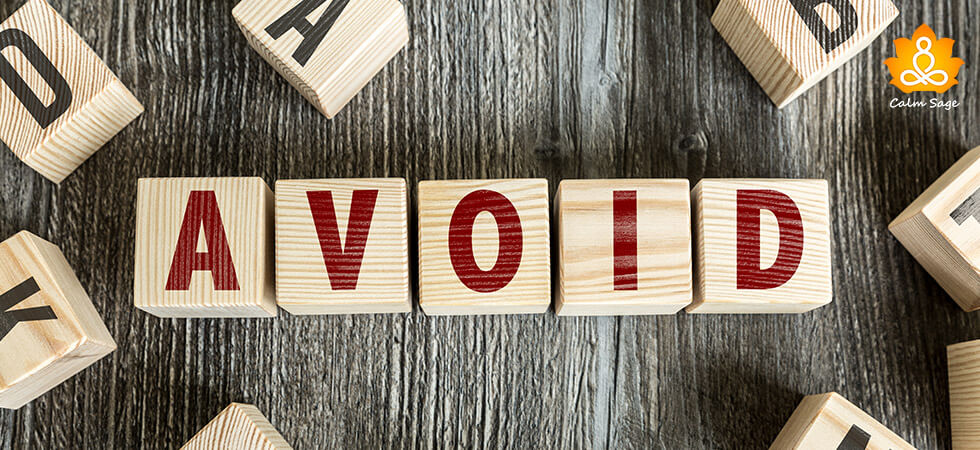The 5 Types Of Avoidance Behaviors (And What They Look Like)

When things get tough and when we are forced to embrace uncomfortable emotions, the best course of action during those times seems like avoidance. Haven’t you ever tried to avoid people, events, or things that you know will result in an uncomfortable outcome?
While avoidance behaviors may sound like the best solution at times, it’s often not. Yes, avoiding a tough situation or unpleasant emotions may give you temporary relief but what about in the long run? Certain avoidance behaviors can negatively affect your growth, relationships, and well-being, in general.
In this blog, I’ll help you understand the 5 types of avoidance coping behaviors and what they might look like.
Let’s begin!
What Are Avoidance Behaviors?
Avoidance behavior is an unhealthy coping mechanism that makes you minimize the threat and avoid the anxiety and stress that comes with it. When you engage in avoidance behaviors, you protect yourself from what you see as a threat, and how much you avoid the threat depends on the intensity of the threat.
Of course, what you perceive as a threat differs greatly from what I believe is a threat.
Often time, these threats are irrational fears that stem from a negative experience (for example, you were in a minor accident so now you avoid traveling by car), and other times, these threats are cognitive (for example, you read about car accidents and their fatality so now you avoid traveling by car).
Understanding why you engage in avoidance behaviors can help you address them appropriately. Here are 5 types of avoidance behaviors that you should know about.
The Types Of Avoidance Behaviors
1. Situational Avoidance
Situational avoidance behaviors are one of the most common types of avoidance behaviors. This avoidance behavior is when you stay away from places, objects, activities, and even people who might trigger your threat response aka flight. This avoidance behavior is also a symptom of PTSD (Post-traumatic Stress Disorder).
Examples of this avoidance behavior can be; when a war veteran avoids activities with loud and sudden noises. This avoidance behavior might also be common in people who generally avoid crowded places, struggle with eye-contact anxiety, etc.
2. Cognitive Avoidance
This type of avoidance behavior is in the mind. Cognitive avoidance behavior is when you avoid your distressing thoughts and unwanted memories. For example, when you tell yourself to consciously not think about certain things. This avoidance behavior could include distractions, dissociation, daydreaming, and even toxic positivity.
In this type of avoidance behavior, you fill your mind with thoughts that overpower the distressing ones and repeat phrases in your mind to drown out uncomfortable memories or thoughts.
More often than not, this avoidance behavior can look like chronic worrying, obsessive thinking, and “what-if” thinking.
3. Protective Avoidance
Protective avoidance behaviors are the actions you engage in to help you feel protected. A classic example of this type of avoidance behavior can be, compulsive cleaning. Protective avoidance behavior can be associated with obsessive-compulsive disorder (OCD).
Other times, protective avoidance can look like,
- Keeping lucky charms
- Counting stairs
- Following a ritual, etc.
This behavior can also be associated with procrastination. When you over-prepare for something, it can act as a protective avoidance to put off something you’re not looking forward to.
4. Somatic Avoidance
Somatic avoidance behavior is when you stay away from situations or events that may cause a physical response such as a rapid heartbeat, tingling sensations, panic attacks, or similar physical responses.
If you have a somatic avoidance behavior type, then you’re also likely to avoid activities that may trigger these responses such as thrill rides, surprise events, etc. Other examples of avoidance behavior under this type can include:
- Avoiding falling in love
- Avoiding excitement
- Avoiding exercising, etc.
5. Substitution Avoidance
Substitution avoidance behavior can be internal or external. When it’s internal, it can look like replacing uncomfortable feelings with other similar yet acceptable ones (for example, replacing sadness with anger or denial). If it’s external, then it can look like using an unhealthy means to cope with emotional distress (for example, using alcohol to chase away your sorrows).
This avoidance behavior can be associated with substance abuse disorder. The idea of this avoidance behavior is to numb yourself to uncomfortable feelings, thoughts, and emotions.
Substitution avoidance behavior can be commonly seen as engaging in risky and addictive behaviors to avoid unpleasant feelings, emotions, people, thoughts, and events.
Getting Help…
Avoiding unpleasant situations, people, activities, or events is OK, sometimes. However, when your avoidance behaviors begin to affect your life, relationships, and emotional well-being, then it needs to be addressed.
If you’re struggling with avoidance behaviors and their effects, it is recommended that you speak to a mental health professional and get the right help. Therapy can help you understand the cause of the avoidance, express emotions constructively, learn healthy coping mechanisms, and self-regulate emotions in tough situations.
Sometimes, avoidance can be OK but when it becomes a part of your life, it can prevent your growth and life satisfaction over time. With the right help, seek support, and learn to overcome your avoidance behaviors.
I hope this blog helps you identify your avoidance behavior. For more, you can write to us at info@calmsage.com or DM us on social media. You can also share your thoughts on the same in the comments section below!
Take Care!
Next Read:




















